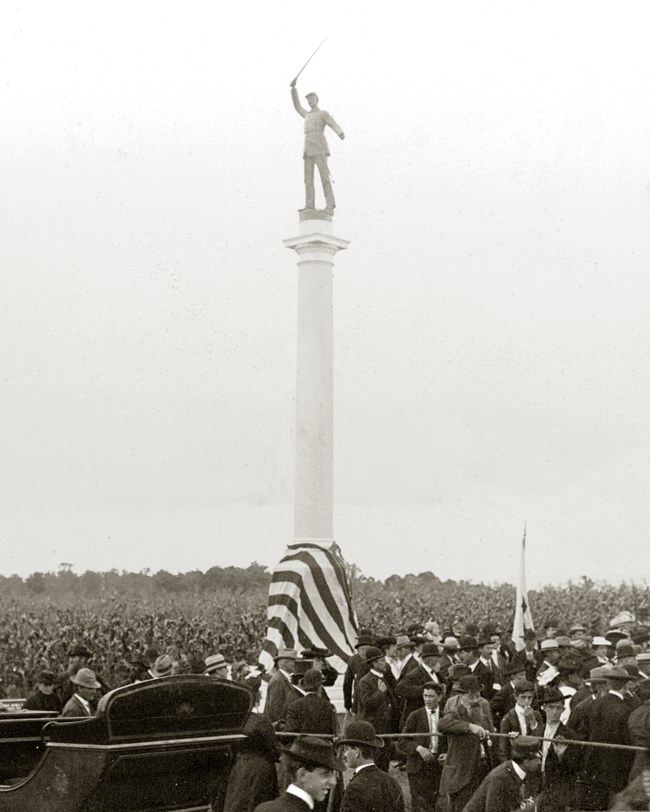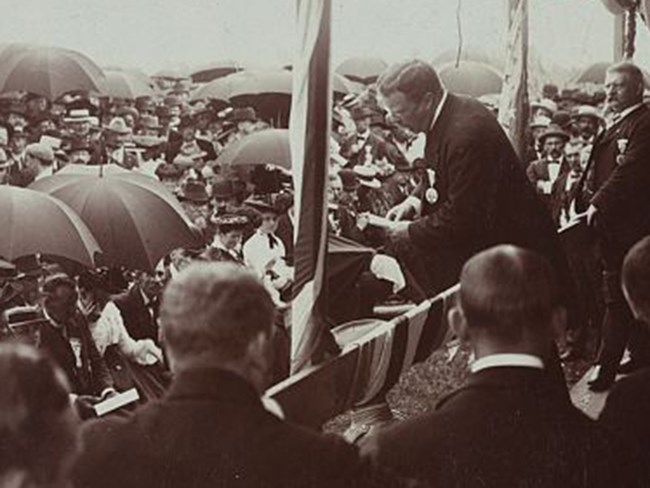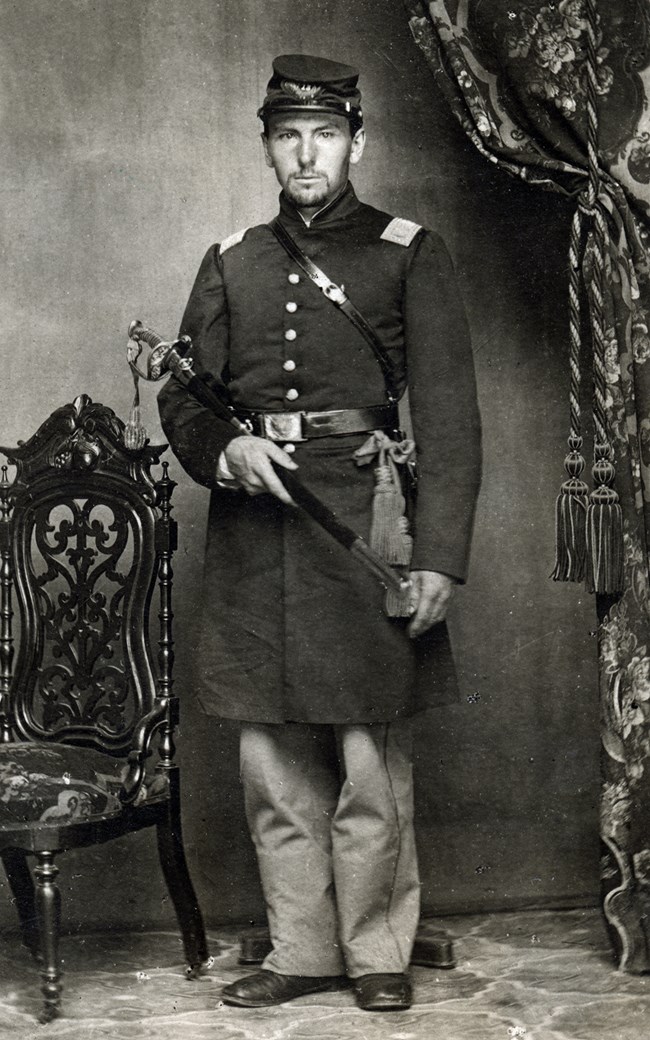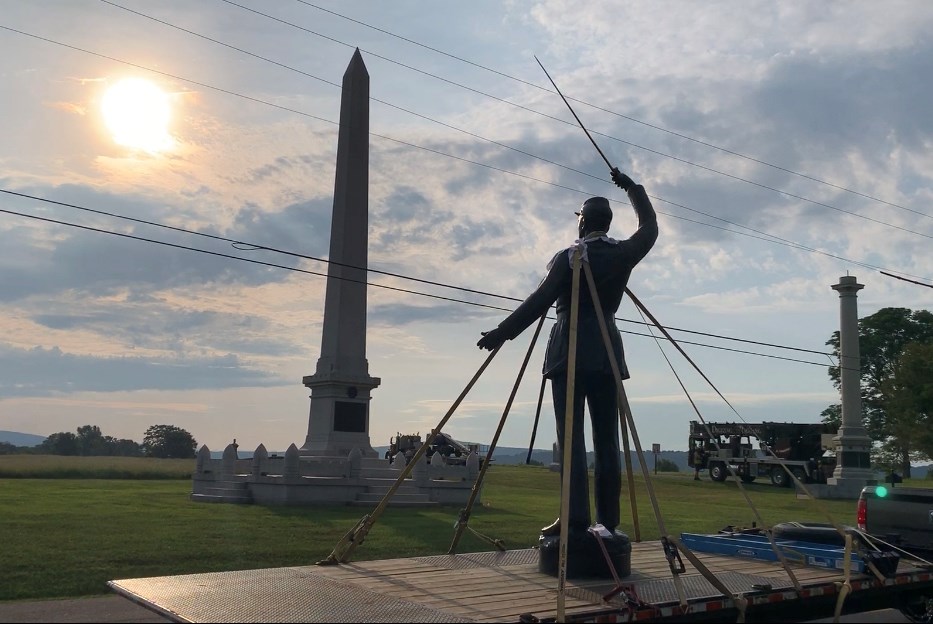
NPS Antietam Library The New Jersey State Monument has a hexagonal base, and on each side there is a plaque commemorating each unit from the state that fought at Antietam. A tall granite column rises out of the center, topped with a bronze soldier raising his sword. Shortly before it was shipped to Sharpsburg to be raised, workers noticed the granite shaft was damaged and a new one had to be cut and polished. The order was rushed, and it did arrive in time for the dedication. 
Image cropped from stereo view, Library of Congress The DedicationPresident Theodore Roosevelt delivered the main address at the dedication on September 17, 1903, the 41st anniversary of the battle. Thousands of people attended, including over four-hundred veteran “survivors” of the battle.Roosevelt stood on the platform and declared: If the issue of Antietam had been other than it was, it is probable that at least two great European powers would have recognized the independence of the Confederacy; so that you who fought here forty-one years ago have the profound satisfaction of feeling that you played well your part in one of those crises big with the fate of all mankind. You men of the Grand Army by your victory not only rendered all Americans your debtors for evermore, but you rendered all humanity your debtors. Just as the President started his address, the skies opened, and an incredible rainstorm moved through the area. Fortunately by the afternoon, the sun was out and the President went on a tour of the battlefield. 
NPS/Antietam National Battlefield, Hann Collection The SoldierThe Battle of Antietam was the first time the men from the 13th New Jersey engaged in battle. Hugh Irish was the captain of Company K, and before he left home, his wife Betsy asked him what she was to tell their two children if he were to never return home. He responded by saying, “Twere better for my boys to be without a father than to be without a government under which to live.” Hugh wrote his last letter home September 14 but never finished it. He told his wife that, “Sleep is sweet to the tired soldier, and looking upwardly at the bright stars and beautiful sky, I think of loved ones at home and that encourages me to live to meet them again.”Irish was killed leading his men across the Hagerstown Pike on the morning of the battle. His friend, Heber Wells, was able to collect Hugh’s sword, diary, and pocket watch, which were all returned to Betsy, before having to retreat with the rest of the regiment back to the safety of the East Woods. The soldier on top of the monument depicts Captain Hugh Irish leading his men into the fight. 
NPS Antietam/ B.Baracz The Monument TodayIn the summer of 2019, the Historic Preservation Training Center, HPTC, restored and rehabilitated the monument. The height of the monument, which is approximately 40 feet tall, and its proximity to adjacent powerlines made the process challenging. Workers could use lifts or scaffolding to reach the top of the monument, but their safety around the powerlines was a big concern. Ultimately, the park contacted the power company and linemen pulled the lines back several feet to allow a greater distance between the wires and the work area. Staff also removed the bronze statue from the stone pedestal to a secured area and performed the cleaning and lacquering at ground level.Due to the difficulty of performing routine maintenance on this monument, nature had taken its toll on the bronze surface. The wax finish that once protected the bronze, had largely weathered away, which allowed thick surface growth and corrosion to coat the metal surface. Cultural Resources staff lightly blasted the statue with crushed walnut shells to remove the film without disrupting the surface patina of the bronze. Once the monument was clean, monument workers applied a new surface protective coat. Typically, the park’s sealant coatings are wax, applied in three coats and hand buffed for a luster finish. Normally, the bronze is treated every three to five years, but that was very difficult due to the access problems with this monument. Cultural Resources specialists decided to use an outdoor-grade lacquer that will provide for longer-term protection. This finish will also provide the desired lustrous finish, similar to a highly-buffed wax finish. This unique process will hopefully result in fewer trips up and down the 40-foot structure; the lacquer finish should last for approximately ten years. Today, park staff cares for over 100 monuments, tablets, markers, and cannon across the historical landscape. The National Park Service works hard to keep them in the same condition as the day they were placed onto the battlefield. |
Last updated: June 8, 2020
